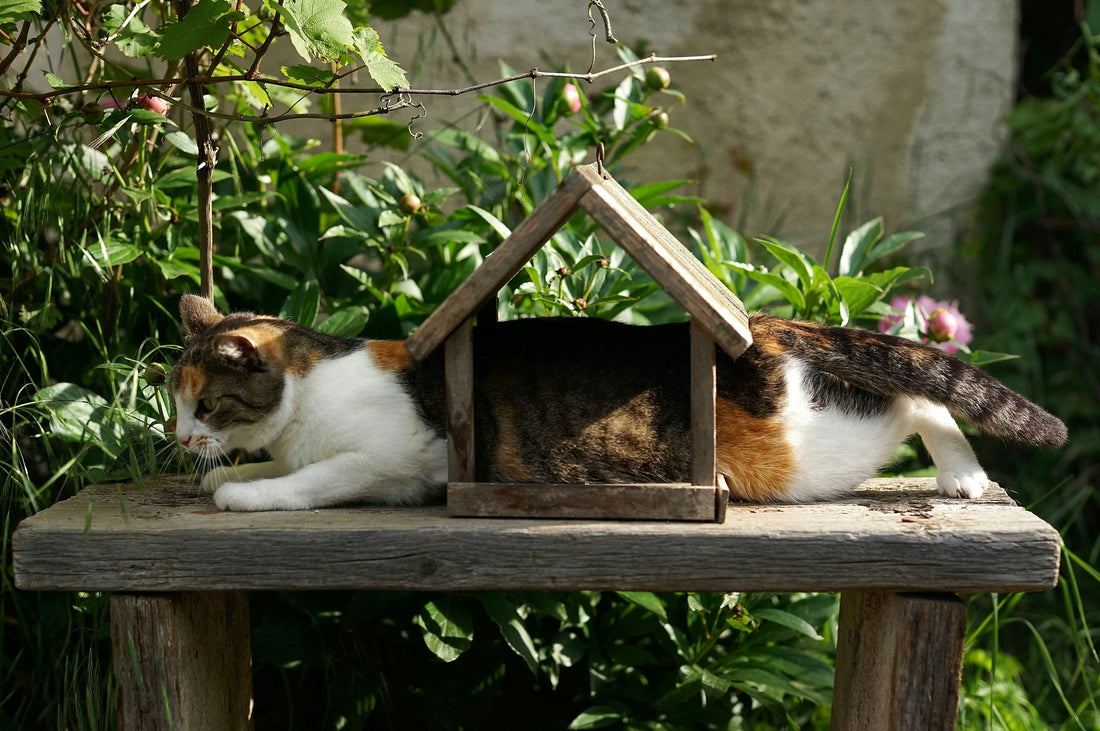
5 Cat Personalities Explained: Is your kitty bored or just relaxed?

Imagine your cat, perched high on your bookshelf, eyes gleaming with mischief as they prepare to swat down the very last book you so carefully stacked. Or perhaps they're stretched out in a sunbeam, not a care in the world, as if they’ve achieved enlightenment through the sheer act of napping. These aren’t just random moments; they’re windows into your cat’s personality, a telling glimpse into the workings of your cat’s behavior.
While these quirks may seem amusing at first glance, they can also be clues to deeper needs. Maybe that playful destruction isn’t just a bid for attention, but a sign of boredom—a curious kitty’s mind craving more engaging interaction. Or that serene nap might not be pure contentment but rather a response to under-stimulation.

Recognizing these subtle signs is crucial, as understanding and addressing them through the right enrichment can prevent behavioral issues and keep your feline friend mentally and physically healthy. Could it be you’ve got a Mischievous Maverick who sees every object as a potential target, or perhaps a Lazy Lounger who’s perfected the art of doing nothing but stretching out next to their favorite scratching post? As you read on, we’ll delve into these and other distinct cat personalities, each with their own tell-tale behaviors and ways to keep them happy and entertained.
Ready to explore? Jump to your cat’s personality type here: Lazy Lounger, Mischievous Maverick, Social Butterfly, Cautious Contemplator, or Ravenous Ransacker.
The Lazy Lounger

Meet the Lazy Lounger, the epitome of feline relaxation. This cat has truly mastered the art of doing absolutely nothing, finding their bliss in long, uninterrupted naps. You’ll often find them sprawled out in the warmest spot in the house, basking in a sunbeam as if they’re soaking up every last drop of warmth. Their motto? Why move when you can snooze?
Personality Traits:
The Lazy Lounger is your quintessential laid-back cat, with a slow-paced lifestyle that revolves around comfort. This feline prefers to stay close to their favorite cushion, barely lifting a paw unless absolutely necessary. They might give you a slow, loving blink or a gentle purr when you’re near, but don’t expect them to leap into action at the sight of a feather wand. For them, the ultimate joy is found in the simple pleasures—sleeping, stretching, and occasionally shifting to a new sunspot.
Signs of Boredom:

Although the Lazy Lounger might appear content with their idle lifestyle, there’s a fine line between relaxation and boredom. If your cat starts sleeping even more than usual or shows little to no interest in anything, even their favorite cat toys—it could be a sign they’re under-stimulated. Without the right engagement, this behavior can lead to unwanted consequences like weight gain or even depression. It’s important to introduce gentle activities and enrich their environment to keep their mind and body healthy.
Tips for Engagement:
- Interactive toys: Start with slow-paced interactive toys that don’t require much movement but can still engage their mind. A feeding puzzle mat, for example, can entice them to move a little more than usual, especially if there’s a tasty reward involved.
- Window perch: A window perch can be a game-changer. Position it where they can watch birds or passing cars, providing mental stimulation without needing to chase anything. This simple setup can transform their day from mundane to mildly exciting.
- Gentle play sessions: While the Lazy Lounger isn’t going to participate in a marathon play session, short, gentle sessions can encourage a bit of movement. Use toys that move slowly or mimic prey in a relaxed manner, so they don’t feel overwhelmed.
The Mischievous Maverick

Personality Traits:
The Mischievous Maverick is your home’s resident explorer, driven by an insatiable curiosity. They’re energetic, clever, and have a knack for finding themselves in places they shouldn’t be, like inside your wardrobe or nestled in your sock drawer.
Signs of Boredom:
While their antics can be amusing, a bored Mischievous Maverick is a force to be reckoned with. When their need for mental stimulation and adventure isn’t met, they’re more likely to engage in destructive behaviors. This can range from scratching up your favorite armchair to knocking down anything and everything that isn’t bolted down.
Tips for Engagement:

- Scheduled playtime: Focus their energy into structured play sessions. By setting aside time each day for interactive play, you can challenge them both physically and mentally.
- Rotate toys: Keep their environment ever-changing by rotating their toys regularly. This prevents them from getting bored with the same old playthings and keeps their mind engaged.
- Puzzle feeders: Challenge their problem-solving abilities with puzzle feeders. These toys require them to work out how to get the food, satisfying their need for mental stimulation and giving them a reward at the end.
- Cat Tracker: If your Maverick is an outdoor explorer, consider a cat tracker like Tabcat. This can give you peace of mind while they roam, ensuring they don’t venture too far from home.
The Social Butterfly

Personality Traits:
The Social Butterfly is friendly, vocal, and always in search of attention. Whether it’s rubbing against your legs, nuzzling up to guests, or simply making sure they’re never out of sight, this cat is the epitome of a people-oriented pet.
Signs of Boredom:
Despite their outgoing nature, even the Social Butterfly can feel the sting of loneliness. Clinginess, excessive vocalization, and an almost desperate need for constant attention are signs that your social kitty might be feeling neglected or bored.
Tips for Engagement:
-
Regular playtimes: Schedule interactive play sessions at regular intervals throughout the day. This gives your Social Butterfly something to look forward to and satisfies their need for interaction.

- Social toys: Use toys that mimic social interactions, such as feather wands or laser pointers that they can chase. These toys can simulate the hunting and chasing they would do in a more social environment.
- Outdoor exploration: Take your Social Butterfly on short walks around the garden or outdoors. Exploring new environments can satisfy their curiosity and need for interaction. To ensure their safety, use a cat tracker like Tabcat to find them if they go rogue.
- Variety of activities: Mix up their routine by introducing new toys, games, or even teaching them simple tricks. This keeps their mind engaged and prevents them from getting bored with the same activities day after day.
The Cautious Contemplator

Not every cat is a socialite. The Cautious Contemplator is the feline equivalent of the wallflower—content to watch from the sidelines, but not so keen on joining in. These cats are shy, cautious, and prefer a quiet, predictable environment.
Personality Traits:
The Cautious Contemplator thrives in predictability. Sudden changes or loud noises can send them retreating to their safe spots, often behind the sofa or under the bed. They may seem aloof, but it's just their way of coping with the overwhelming world around them.
Signs of Boredom:
While they may seem content with their solitary ways, even the Cautious Contemplator needs mental stimulation. Signs like constant hiding, hesitance to explore new areas, or excessive grooming can be subtle cries for help.
Tips for Engagement:

- Safe spaces: Provide plenty of safe, cozy spots where they can retreat to when feeling overwhelmed. Covered beds, boxes, or even a dedicated room can offer them a sanctuary from the hustle and bustle of daily life.
- Slow introductions: Introduce new toys or activities gradually. Let them explore at their own pace without pressure.
- Calming environment: Consider using calming pheromones or playing soft, soothing music to create a stress-free atmosphere. These small changes can make a big difference in helping your Cautious Contemplator feel more secure.
The Ravenous Ransacker

Personality Traits:
The Ravenous Ransacker is driven by a need to explore, often seen rummaging through cupboards or stalking the kitchen counters. Their natural curiosity and energy levels are high, and they’re always ready to pounce on an opportunity to taste-test anything that comes their way.
Signs of Boredom:
While it’s easy to chalk up their behavior to gluttony, their relentless focus on food and mischief might be a sign of boredom or anxiety, especially in cats with a history of food scarcity. If they’re constantly foraging or getting into things they shouldn’t, it could mean they need more mental stimulation.

Tips for Engagement:
- Structured Playtime: Channel their energy into regular, interactive play sessions that mimic hunting. This not only satisfies their natural instincts but also distracts them from food-focused behavior.
- Strict Feeding Schedule: Establish strict feeding times to help them understand boundaries. This will also help prevent the overindulgence that can lead to weight gain.
- Interactive Toys: Introduce toys that require problem-solving or mimic prey. These will keep their mind engaged and prevent them from turning to the kitchen for entertainment.
Conclusion
Cats are complex creatures, and their personalities can greatly influence how they interact with their environment. Understanding whether your feline friend is a Lazy Lounger, a Mischievous Maverick, a Social Butterfly, a Cautious Contemplator, or a Ravenous Ransacker can help you tailor their enrichment and care to keep them happy and healthy. Recognizing the signs of boredom, stress, or under-stimulation is the first step in preventing behavioral issues and ensuring your cat lives a fulfilling life.
Remember, every cat deserves to be understood and cared for in a way that suits their unique personality. Whether it’s through interactive toys, safe spaces, or structured playtime, providing the right kind of enrichment is essential for their well-being. And for those mischievous explorers, consider using a cat tracker to keep them safe during their adventures.
 UK
UK
 USA
USA
 GLOBAL
GLOBAL
